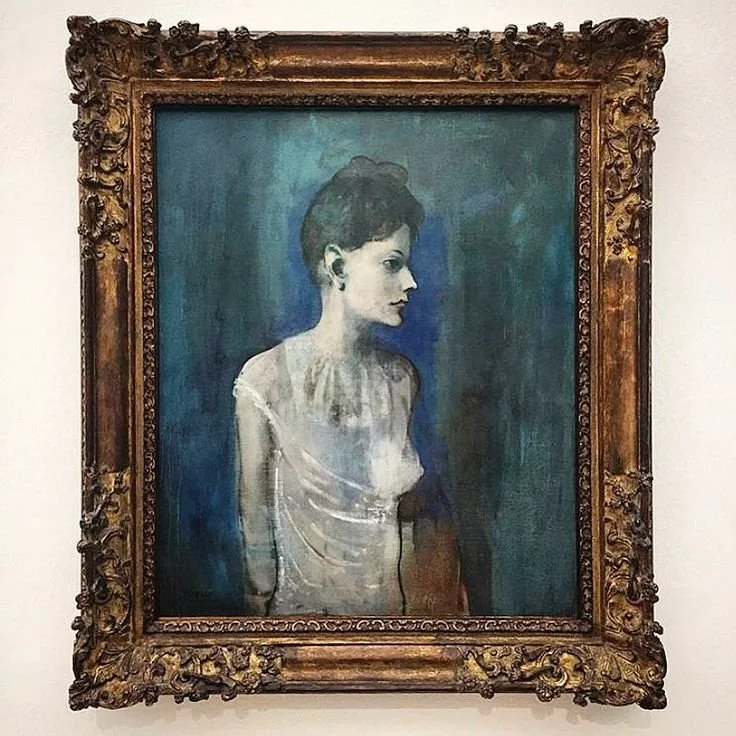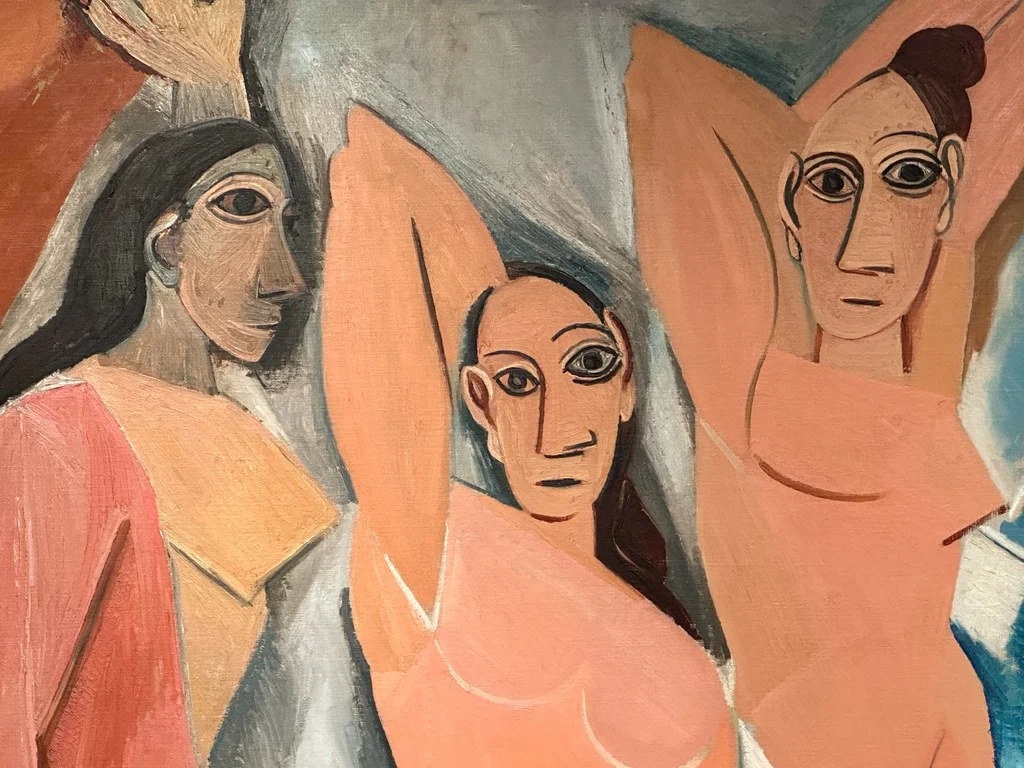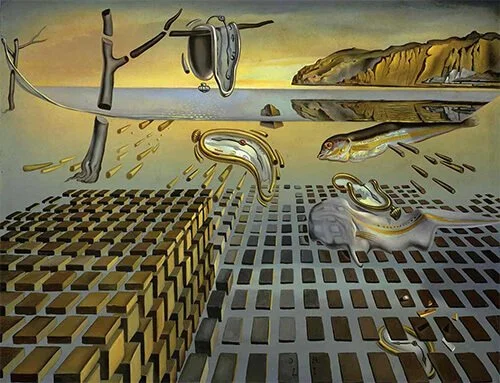Disrupting The Canvas, Picasso and the birth of Moderism.
Picasso in Paris 1904
The Beginings of a movement
To speak of Pablo Picasso is not merely to consider a painter but to confront a cultural insurgent. He was not born into modernism; he forged it like iron, against the pressures of convention and the decay of past aesthetics. The modernism he helped define was not a gentle evolution but a rupture, an aggressive act of reinvention. And at the centre of that revolution lies Les Demoiselles d’Avignon, a painting that tore history into a before and after.
“The Suicide” "(Casagemas) 1901
The Blue Period
But before this rupture, Picasso’s Blue Period (1901–1904) held a different kind of quiet defiance. Following the tragic death of his dear friend and Artistic companion Carles Casagamos (1880-1901) which drew Picasso into a long and significant melancholy and gave impetus to his definitive ‘Blue Period’. These were never sentimental images, though they are often treated as such. La Vie, The Old Guitarist, Mother and Child by the Sea, these are not merely mournful scenes steeped in melancholia. They are, more fundamentally, acts of witnessing. As I have said before, every image presents not only a way of seeing but a proposition about the world. The Blue Period is Picasso’s proposition that beauty must reckon with despair. These figures are gaunt, ghostly, alienated and, crucially, dignified. They do not beg for our pity. They challenge the economic and social structures that produced their condition.
“Girl in a Chemise” 1904
In the Blue Period, we already sense a dissatisfaction with representation. The elongation of limbs, the unnatural palette, these are attempts to escape the tyranny of realism. They hint at what’s to come: not abstraction for its own sake, but an urgent reconfiguration of how the world can be shown against its perceived better judgement.
Les Demoiselles d’Avignon
That transition comes violently with Les Demoiselles d’Avignon in 1907. It is a painting that breaks faith with everything preceding it. There is no atmosphere, no illusion of depth, no decorum. The five women are not subjects to be admired, nor objects to be possessed. They look directly, accusingly at the viewer. Their forms are sharp, their anatomy brutalized, their faces, especially the two rightmost, carved with African masks. What we are seeing is not an exotic deification, but Picasso attempting to borrow another language entirely, one older, rawer, unfiltered by the classical canon.
The controversial demoiselles d’Avignon 1907
This was not merely a formal innovation. It was ideological. The Renaissance had taught Western painting to position the viewer as a master: calm, centred, in control. Les Demoiselles turns the viewer into the object, penetrated by these five unmoved, uncaring eyes. This is not just painting; this is non-conformity personified.
Introduction of Cubism
The collaboration with Georges Braque that followed from this moment led to the development of Cubism, a movement that did not depict the world but dismantled it. Analytic Cubism unstitched the visible surface of things: a guitar, a café table, a pipe, all became disassembled ideas rather than objects. The canvas became a plane for thought rather than illusion. Perspective, the very backbone of Western visual logic was no longer central. One might call Cubism cerebral, but that underestimates its radicalism. It was not an aesthetic shift. It was a dismantling of the contract between art and viewer, between image and reality.
George Braque “Man With a Guitar” 1914
And so, the Bourgeois recoiled. Cubism and its progeny were not only difficult to consume they were difficult to commodify. And that made them dangerous. The art academies, the salon-goers, and later, the fascist regimes, were quick to brand such work “degenerate.” The art of Picasso, Braque and their contemporaries was too resistant to serve any coherent narrative of nation, tradition, or purity. That it eventually found its place in museums is a testament to modernism’s assimilation into the capitalist machine but at the time, it was insurgent.
Salvador Dali “The Persistence of Memory” 1931
Those Who Followed
What followed in modern art bore the fingerprints of this rupture. Salvador Dalí, though operating under the surrealist banner, owed much to Cubism’s challenge to representation. His melting clocks in The Persistence of Memory do not seek to show reality but to fracture time and identity Cubism’s spatial fragmentation becomes, in surrealism, temporal and psychological fragmentation. Symbolism, in Dalí’s hands, becomes another weapon against the materialist logic of the 19th century.
Andy warhol “The last Supper” 1986
Later, in the 1960s, Andy Warhol and Roy Lichtenstein brought their own form of disruption. On the surface, Pop Art seems the antithesis of Picasso’s emotionally and politically charged work. But in truth, Pop owes its boldest provocations to the precedent set by Cubism: that art can be reflexive, can expose its own constructedness. Warhol’s soup cans and celebrity portraits are not just images; they are critiques of mass reproduction and consumption and the reimaginings of Classic works for a more Modern and over-produced weary audience. Like Les Demoiselles, they resist beauty in favour of confrontation. Lichtenstein’s comic panels, mimicking the printed page, continue the Cubist tradition of borrowing from “low” or “non-art” sources.
Art as a Commodity
Picasso, then, was not the end of an era but the opening gambit in a century-long reimagining of what art could do. That his works today fetch staggering sums many tens of millions at auction has prompted some to ask whether he is to blame for the commodification of “degenerate” or modern art. Did he, in breaking the rules, make art into a luxury good?
Picasso's 'golden muse' sold for £49.8 million at Sotheby's
It is a fair question. And yet, to reduce Picasso’s legacy to economics is to misunderstand it entirely. He did not create art to sell it. In fact, much of his most revolutionary work like Les Demoiselles was not even shown to the public for years. It was too shocking. His refusal to leave Paris during the Nazi occupation, his defiant Guernica painted in response to the bombing of a Basque town by Franco’s forces these are not the actions of a man concerned with market value. These are acts of moral engagement.
Yes, the art market has used Picasso. But it is not he who turned art into speculation it is the very Status quo that once denounced him, now profiting from what it could not suppress. To argue that Picasso is responsible for inflated prices is to confuse the symptom with the cause.
Picasso undeniably The greatest influence on art in the 20th century
Legacy
Picasso’s influence on the direction of 20th-century art is undeniable and overwhelmingly positive. He freed art from the burden of representation, allowing it to become philosophy, protest, psychology, and dream. In doing so, he passed the torch to Dalí, to Warhol, to countless others who understood that to make art is not to imitate the world, but to remake it.
In disrupting the canvas, Picasso disrupted the world’s ability to look away. He gave art a new grammar sometimes brutal, often enigmatic, always alive. And in that grammar, the story of modernism was written. Not as a decorative flourish to history, but as its radical alternative.








